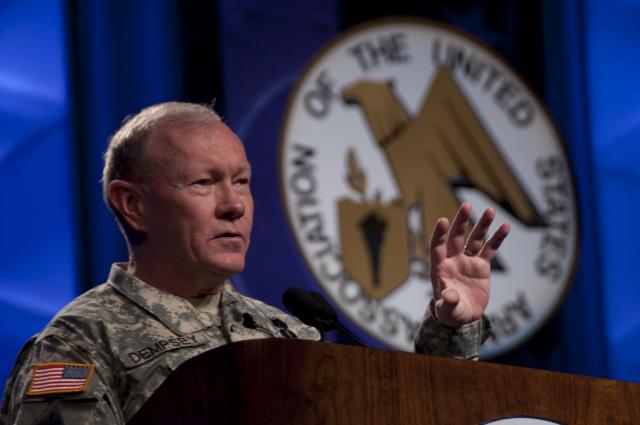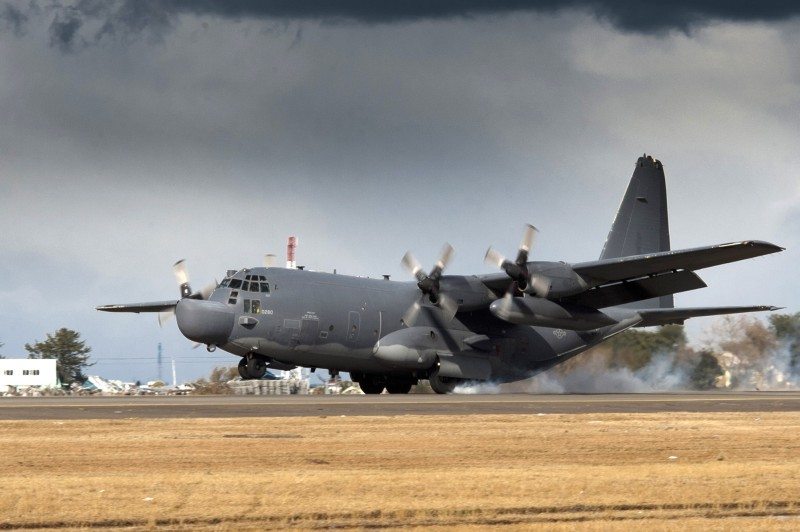Army Chief of Staff Gen. Martin E. Dempsey brought his intent for the Army of 2020 to the Association of the U.S. Army Institute of Land Warfare breakfast, leading off with a video accompanied by a song played by a band called “Disturbed.”
“I’m a little short of a month in my new job and I’m trying to feel what the Army is all about,” said Dempsey, adding too much time is spent trying to understand the Army when what really makes the Army is the way Soldiers feel about themselves.
He used the song in his video as one of the ways he reaches out to the young Soldiers whom he knows would immediately know the band. Of the senior leaders in his audience, for example, only one Soldier knew the singer at this morning’s Association of the United States Army breakfast.
But the Army, he said, has a sense of history. It has existed for 235-plus years with leaders who change constantly and continue to build on a legacy. This is important to understand, he said, when examining where the Army is and where it’s heading.
Besides the video, he had a photograph of a Soldier downrange.
“On this notion of feeling the Army, I’ll tell you how I spent most of my time in the three weeks that I’ve been the 37th Chief,” Dempsey said.
He first went to the Virginia Military Institute to take part in the Marshall Awards for the best and brightest of the ROTC cadets across the country.
“This group is eager to join our profession, eager to belong, eager to contribute, eager to collaborate, eager to understand, but also eager to feel what this thing is all about,” he said.
“Now take a look at that photograph again. This one really gets at some things that are important to me: trust and fitness and discipline, but especially trust,” Dempsey explained. “So, this image is not only about what that young leader is going through in trying to work through a very uncertain situation, but he’s got a wedding band on and that kind of reminds you of the families that are part of this wonderful institution.”
“He’s got a Soldier there watching his flank and he trusts that Soldier to do his job so that he can do his,” he continued.
DEMPSEY’S FOCUS AREAS
This brought Dempsey to his focus areas, a framework, he said, that by the time of the Army birthday, June 14, will be published with the possible title, “The Chief of the Staff of the Army’s Intent.”
“This will allow me to express my intent from a broad statement of the role of the Army,” he said.
His nine focus areas are: The Nation, The Joint Fight, The Profession, The Army Family, Leader Development, Mission Command, Squad, Human Dimension, 21st Century Training.
“One of the things my transition team did for me is to help me understand that the force is wondering, ‘what happens after Iraq and Afghanistan?’ Well, we’re going to try and answer that question in this particular document,” Dempsey said.
This will be a collaborative effort, he said, among the senior military and civilian leaders.
“I’ve had several, what I think are, terrific sessions with Secretary of the Army John McHugh, who is a wonderful teammate, I mean he’s my boss, but he’s a wonderful teammate in this effort to try and articulate what we’re about, a little differently.
The focus areas, he said, help him to bundle initiatives under each area, make sense of them, and help people understand how, for example, the Human Dimension can be delivered.
“So I’m not going to walk my way through all of them there, but those are the focus areas I’ve selected. The staff is working on some suggestions I’ve given them about initiatives that will nest underneath those focus areas so that we can actually deliver them.
THE NATION
“It occurs to me that whatever we do with this Army through the next four years, this team that I and the secretary have will build the Army of 2020.
“Whether we do it (purposely) or inadvertently, we will have a clearer understanding of what the nation needs, and that’s the point. What does the nation need of us in 2020 and how do we move ourselves from where we are today to where we need to be in 2020,” Dempsey said.
The other aspect of this, he said, is giving the nation the most options possible.
“The Army has always done that and always truthfully done that better than anyone. And we will continue to do that as we decide what this Army of 2020 should look like,” he said.
Dempsey said the Army is connected to the nation today in ways that are absolutely brilliant.
“We are in conflict, the nation knows we are in conflict, they support us in that conflict – thank God – but we have to think through what changes will be needed when the conflict begins to diminish. How do we stay connected with America,” he said.
THE PROFESSION
“As we build this Army of 2020, clearly we’re going to build it to meet the needs of the combatant commander. The study of the profession is resonating out in the force and it’s resonating not just with officers, but with noncommissioned officers, warrant officers, active, Guard and Reserve and with our DA civilians.
“It’s resonating because the other thing the Army brings to the nation is it brings a sense of belonging. People really want to belong to something today and we should reinforce that and we should take advantage of that and we are. As we look at what it means to be a professional, this will cause us, I believe, to change some of the attributes by which we describe the profession,” Dempsey said.
Dempsey said this will cause the Army to look at policies, such as personnel policies.
“We’ll decide if there are policies that potentially erode the profession – promotion rates, for example, so that we actually can determine earlier within the profession who is meeting those professional credentials that we desire,” he said
THE SQUAD
“When I first put up the squad as a focus area, I was questioned by my transition team. Here’s my motivation: I’ve seen the Army in the last 10 years of my career, from the top down, and thinking about the Army and where it over matches its potential adversaries.
“We don’t want to send a Soldier into harm’s way who doesn’t over match his potential enemies. It’s at the squad level where it becomes too much of a fair fight. So, the motivation was to lie on my back and look up and look at the Army from the bottom up, and see what that does. It’s a focus area,” Dempsey said.
Over the last years of war, he said, the Army has pushed a lot of things to the edge.
“In so doing, we’re learning as we push these things to the edge. So you push all these ’emitters,’ let’s call them, all of which require some kind of power and energy to drive them, and all of a sudden you find yourself in a situation where the squad is almost overwhelmed by the requirement for batteries,” he said.
Dempsey used a cliche’ common in Afghanistan to illustrate his point.
“You can follow a U.S. infantry patrol by the disposable batteries that it trails behind it, almost like breadcrumbs, to find their way back to their FOB. The question is, what does the squad need? When we figure that out, then we figure out a way to deliver it,” he said.
To alleviate this, he said, TRADOC is producing a capabilities-based assessment and an integrated capabilities document that will actually establish the requirements – what it means to be a squad and how does the Army empower that squad to do its job?
SUMMING UP
“I have another image I carry around in my head. The way the squad entrenches itself today is with the entrenching tool. This is the 21st century and I’m just not convinced that the best we can do is an entrenching tool,” Dempsey said.
Dempsey said he is reminded of a Jerry Seinfeld episode where the Chinese steadfastly stay with the chopsticks, just like the Army sticks with tradition.
“And they’ve seen the fork,” Dempsey said. “And I sometimes feel that way about some of us. So, we’re going to try and see ourselves a little differently and I want to see it from the bottom up and then decide what it looks like,” he said.
There are two core competencies the Army must provide the nation, he said. It must be able to maneuver to seize the initiative when it doesn’t have it and it must be able to establish security over wide areas to consolidate the gains that are made by maneuver.
“I think we should all put our shoulders to that and make sure we don’t make mistakes along the way,” Dempsey said.











